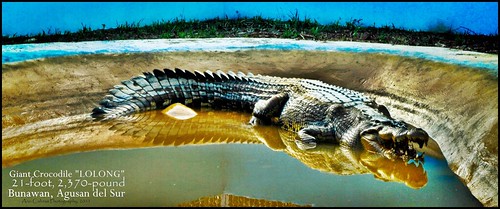Freedom By Death: RIP Lolong
by , 02-10-2013 at 11:31 PM (17268 Views)
Photo: Ann Cabras
8:05PM Today
Lolong died in captivity, confirmed by Bunawan, Agusan Del Sur Mayor. Lolong is said to be the largest crocodile in captivity.
9:15 PM
I saw a post on facebook about this sad news of Lolong's death. I thought it was a hoax but it seem unlikely, for the one who posted it is my friend, a member of A.C.E (Aquatic Cebu Enthusiast) and has ties in Agusan Del Sur. After scrolling over for details, it was confirmed that Lolong had just died. A tweet from Matanglawin team also confirmed about Lolong's death. It is indeed a sad news to the animal kingdom and to us, especially to me, who never paid a visit of admiration to the innocent beast.
=======================================
The saltwater/estuarine crocodile (Crocodylus porosus) is an opportunistic apex predator capable of taking nearly any animal that enters its territory, either in the water or on dry land. They have also been known to attack humans who enter the crocodiles territory. Juveniles are restricted to smaller animals such as insects,amphibians, crustaceans, small reptiles and fish. The larger the animal grows, the greater the variety of animals it includes in the diet, although relatively small prey make up an important part of the diet even in adults.
Generally very lethargic – a trait which helps it survive months at a time without food – it typically loiters in the water or basks in the sun through much of the day, preferring to hunt at night. Capable of explosive bursts of speed when launching an attack from the water, many species of crocodile are also capable of fast land-movement. Many crocodiles are capable of explosive charges that can carry them nearly as fast as a running human. The 23 species of crocodilian can travel over land using the belly crawl, the walk, the high-walk, and the gallop.
[Source]
=======================================
For how Lolong died is still unclear. Lolong's captor and caretaker, E. Aguillon, treated his wounds caused by the tightened rope bound on his body during capture. This presumably affected the crocodile on a long-term basis, adding stress to the already stressed animal. Also, the arrival of the typhoon Pablo might as well added another weight on Lolong's already stressed state. Considering saltwater crocodiles as placid and lethargic, they would just sink off to the bottom of the marsh, breathing when it's necessary while submerged, if the temperature outside is cold (especially if it is a typhoon) to conserve energy since they need heat from the sun to bask , which the absence of it will cause the animal to slow down. Lolong's controlled environment, (in this case, a caged pond) lacks everything that the marsh (his former home) provides, exposing him to the elements that might (or will) render his health and stress.
Why would Lolong end up there in the first place? To guarantee his safety against the public that lives in the area. Lolong has this reputation to eat children (though it is not confirmed), instilling fear on the people that lived there. But to sum it up, the people in Agusan marsh should only consist of the Manobo tribe, which is the only minority that accepted the fact of predator-prey relationship of crocodiles and men. However, both the Manobos and the crocodiles face a new predator; the outsiders, who started enroaching the area for resources.
Sometimes I wonder, what would be the future of Agusan Marsh. Do we need another Lolong to sacrifice for this already-form-of-sacrilege to nature? He might be an abomination of nature, but Lolong is just an animal. I wonder if the most intelligent animal on earth would appreciate such innocence, or rather, continue to follow its "instinct" of insatiable greed.
Yes, I'm talking about us, humans.
Rest in Peace Big Croc.






 Email Blog Entry
Email Blog Entry

